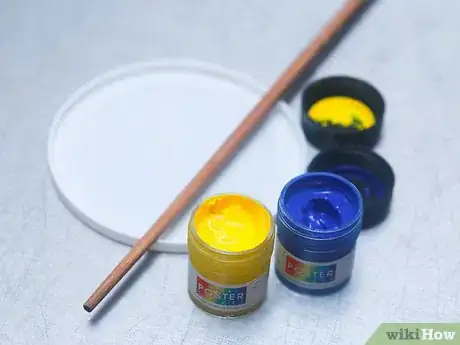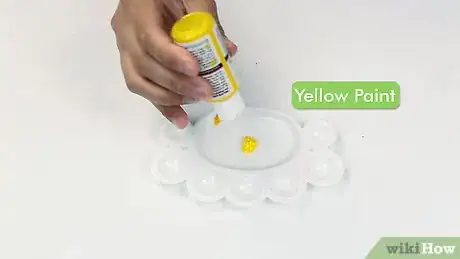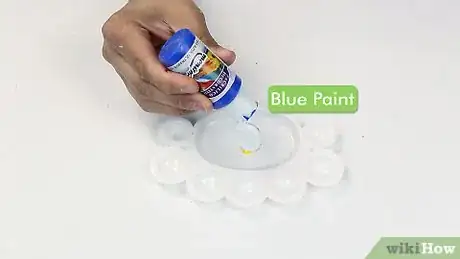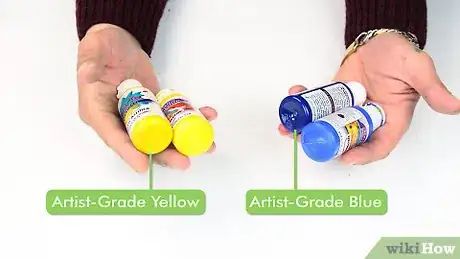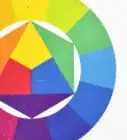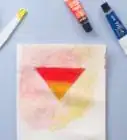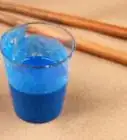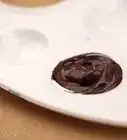This article was co-authored by Jeanine Hattas Wilson. Jeanine Hattas Wilson is a Professional Painter and the President of Hattas Public Murals, Inc. With nearly 20 years of experience, Jeanine specializes in creating, overseeing, designing, and painting murals. Jeanine holds a BA in Advertising from Marquette University and a Studio Painting Minor from The Milwaukee Institute of Art & Design. She has studied at The Atelier Artien in Paris, France, Los Angeles Academy of Figurative Art, and under renowned artists such as Robert Liberace, Michael Siegel, and William Cochran. To date, Hattas Public Murals has painted nearly 5,000 commissioned works of art in homes and commercial and public spaces.
wikiHow marks an article as reader-approved once it receives enough positive feedback. In this case, 100% of readers who voted found the article helpful, earning it our reader-approved status.
This article has been viewed 355,743 times.
One of the most useful colors to be able to mix with paint is green. You can use it to create hills, trees, grass, and many other things. Unfortunately, it is not always easy to mix and often ends up murky, but with a few tips you can learn how to mix green paint. You can use standard paint or artist-grade acrylic, oil, or watercolor paint.
Steps
Mixing Basic Green Paint
-
1Gather your supplies. Many people will reach directly for a paintbrush when mixing paint, but this actually isn't the best option. Not only will you risk ruining your paintbrush, but you also won't get a very smooth color. Opt for a palette knife or popsicle stick instead.
Here is a complete list of what you will need:
• Blue paint
• Yellow paint
• Paint palette, paper plate, or cup
• Something to mix with (palette knife, spoon, popsicle stick, etc)
-
2Put a coin-sized drop of yellow paint onto a palette. This will count as "one part yellow." When mixing paints, you will be working with "parts" as a form of measurement.Advertisement
-
3
-
4Mix the two colors together. Keep mixing the paint until the color is uniform and you don't see any streaks. If you are using a thin paint, like tempra, poster, or craft-grade acrylic paint, try using a spoon or popsicle stick. If you are using a thicker, paste-like paint, such as oil or acrylic, use a palette knife to smoosh and move the paint around until it you get an even color.
-
5Use the paint. You could create a green landscape or use green to mix realistic skin tones. The possibilities are endless!
Mixing Different Shades of Green
-
1Add more yellow if you want a lighter, brighter green. Start with one part yellow and one part blue and mix the two colors together with a pallet knife. Once you have your green, add one extra part yellow and mix again. Keep adding yellow until you get the shade you want.
- Two to three parts yellow and one part blue will give you a bright, lime green.
-
2Add some white if you want a lighter, pastel green.[2] Adding white will also give you more of a minty green. Keep in mind that some whites can be very vibrant. Start with less white than you think you might need.
-
3Darken your paint with some more blue. Start with a basic green color, then mix in one extra part blue. Keep adding blue paint until you get the color you want.
- Two parts blue and one part yellow will give you turquoise.
-
4Add black if you want a darker, duller shade of green.[3] Keep adding the black paint, drop by drop, and mixing, until you get the color you want.
-
5Add red to dull the green down. If you want more of an olive green or an army green, add a drop of red. The more red you add, the more earthy your shade of green.[4]
Mixing Green Using Artist Paint
-
1Know that artist-grade blue and yellow paint come in different shades. When buying artist-grade acrylic, oil, or watercolor paint, look at the colors carefully. You may notice that some of the blues have more of a greenish tint, while others have more of a purple tint. You may also notice that some of the yellows have more of a green tint, while others have more of an orange tint. Choosing the wrong shade of blue or yellow will result in a murky, muddy green.
-
2Purchase the right shade of blue and yellow. To get a bright, vibrant green, you will need to buy blue and yellow paint that both have a greenish tint to them. Here are some combinations to get you started:[5]
- Phthalo blue (Green Shade) and Cadmium yellow light
- Phthalo blue (Green) & Hansa yellow (also called Lemon yellow)
-
3Know what shades to use when mixing a muted green. If you don't want a bright green, then you can use other shades of blue and yellow. You can also use some other colors as well. Here are some combinations to get you started:[6]
- Ultramarine blue & Cadmium yellow light
- Ultramarine blue & Yellow ochre
- Ivory black & Cadmium yellow light
- Prussian blue & Yellow ochre
- Burnt umber & Cadmium yellow light
-
4Use red to tone down green. If your green turned out too bright, don't add black or grey to make it duller. Add a little bit of red paint instead. Red is opposite of green on the color wheel, so it will help tone down the green. The more red you add, the more brown/grey your green will be.[7]
-
5Lighten or darken your green with some yellow or blue paint. Do not use white or black paint; these colors will dull your green. Instead, use a little bit of the yellow that you were using the lighten the green. To darken the green, use a little bit of the blue that you were using. Using yellow and blue will help keep the green bright and vibrant without dulling it down.
- Blue can be a very intense color. Start with a pinhead-sized drop first.
-
6Know when to add black or white paint to your green. If you want to lighten your green into a pastel shade, add some white. If you want to darken your green into a more dull shade, add a little bit of black. Start with a pinhead-sized drop.
Community Q&A
-
QuestionHow do I make a forest green color?
 EnBOOKdsCommunity AnswerPut some green and a tiny bit of charcoal grey or black. Add some blue if you want evergreen.
EnBOOKdsCommunity AnswerPut some green and a tiny bit of charcoal grey or black. Add some blue if you want evergreen. -
QuestionWhat is the right combination of colors to get an apple green mix?
 Community AnswerYou could use the combination of a tincture lemon yellow and light green color. Adding a little white to the mix helps in enhancing the color.
Community AnswerYou could use the combination of a tincture lemon yellow and light green color. Adding a little white to the mix helps in enhancing the color. -
QuestionWhat are primary colors?
 Community AnswerRed (magenta), yellow and blue (cyan) are the primary colors. With these, you can mix pretty much any other. They are called primary because you can´t create them by mixing other colors.
Community AnswerRed (magenta), yellow and blue (cyan) are the primary colors. With these, you can mix pretty much any other. They are called primary because you can´t create them by mixing other colors.
References
- ↑ Jeanine Hattas Wilson. Professional Painter. Expert Interview. 5 May 2021.
- ↑ Jeanine Hattas Wilson. Professional Painter. Expert Interview. 5 May 2021.
- ↑ Jeanine Hattas Wilson. Professional Painter. Expert Interview. 5 May 2021.
- ↑ Jeanine Hattas Wilson. Professional Painter. Expert Interview. 5 May 2021.
- ↑ Will Kemp Art School, Is Green Ruining Your Acrylic Paintings?
- ↑ Will Kemp Art School, Is Green Ruining Your Acrylic Paintings?
- ↑ Will Kemp Art School, Is Green Ruining Your Acrylic Paintings?
About This Article
To mix green paint, blend together equal amounts of blue and yellow paint. For a lighter shade of green, add more yellow paint. You can also get lighter shades of green by mixing in white paint. For a darker shade of green, add more blue paint. You can also mix black paint into the green a little at a time to make it darker. Mixing purple or blue paint into green will give you a cooler green shade, while mixing red or orange paint into green will give you a warmer shade of green. Play around with different color combinations and proportions to find the exact type of green you’re looking for! If you want to learn how to mix green with artist grade paint, keep reading the article!
